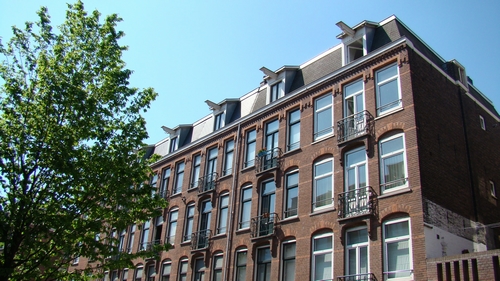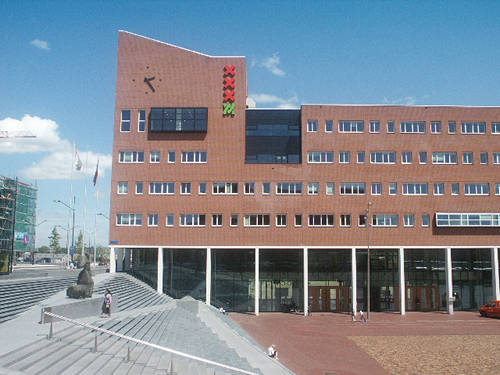|
Houthaven
Houthaven is a neighbourhood of Amsterdam, Netherlands situated in the West borough. Literally meaning "lumber port", Houthaven is a port situated along the IJ in Amsterdam's western port. It is bordered by a dam in the IJ river to the north and the Spaarndammerbuurt in the south. It is currently predominantly used by inland barges, however plans are in motion to radically change the area in the next few years by building a new residential area on seven artificial islands. The harbour is made up out of four parts (from east to west): Oude Houthaven (Old Lumber Port), Houthaven, Nieuwe Houthaven (New Lumber Port) and Minervahaven (Minerva Port). This is why the Houthaven is also referred to as the Houthavens (which is the plural). History The Houthaven was dug out in 1876, together with the North Sea Canal. It was the first port in Amsterdam to be dug out (the earlier ones using existing waters). Its purpose was to tranship and store lumber. As lumber was increasingly transported ... [...More Info...] [...Related Items...] OR: [Wikipedia] [Google] [Baidu] |
Amsterdam-West
Amsterdam-West () is a borough (Dutch: ''stadsdeel'') of Amsterdam, Netherlands, to the west of the centre of the city. This borough was formed in 2010 through the merging of four former boroughs Oud West, Westerpark, De Baarsjes and Bos en Lommer. This part of Amsterdam was built roughly between the end of the 19th century and 1960. In 2013, the borough had approximately 142,700 inhabitants. With about 14,000 inhabitants per km2, West is also the most densely populated borough of Amsterdam. History The borough of Amsterdam-West consists primarily of the pre-World War II part of Amsterdam to the west of the Singelgracht. The western expansion beyond the 17th-century Amsterdam canal belt started in the last quarter of the 19th century. The first neighborhoods to be built were Spaarndammerbuurt, parts of Zeeheldenbuurt, Staatsliedenbuurt, Kinkerbuurt and Overtoombuurt. These neighborhoods are characterised by ''revolutiebouw'' (literally: 'revolution architecture'): quickly ... [...More Info...] [...Related Items...] OR: [Wikipedia] [Google] [Baidu] |
Boroughs Of Amsterdam
The boroughs of Amsterdam ( nl, stadsdelen; literally "''city parts''") are the eight principal subdivisions of the municipality of Amsterdam, Netherlands. Each borough is governed by a directly elected district committee (''bestuurscommissie''). The first Amsterdam boroughs were created in 1981, with other boroughs created in later years. The last area to be granted the status of borough was Amsterdam-Centrum (2002). The existing system of eight boroughs, covering all parts of Amsterdam, is the result of a major borough reform in 2010. The current boroughs have populations of around 80,000 to 150,000, which is equivalent to an average-sized municipality in the Netherlands. Borough government Until 2014, the Amsterdam boroughs had the status of submunicipalities (''deelgemeenten''), a form of government which existed only in Amsterdam and Rotterdam. The borough of Westpoort, however, was governed by the central municipal authorities and therefore not a submunicipality. The submu ... [...More Info...] [...Related Items...] OR: [Wikipedia] [Google] [Baidu] |
Neighbourhood
A neighbourhood (British English, Irish English, Australian English and Canadian English) or neighborhood (American English; American and British English spelling differences, see spelling differences) is a geographically localised community within a larger city, town, suburb or rural area, sometimes consisting of a single street and the buildings lining it. Neighbourhoods are often social communities with considerable face-to-face interaction among members. Researchers have not agreed on an exact definition, but the following may serve as a starting point: "Neighbourhood is generally defined spatially as a specific geographic area and functionally as a set of social networks. Neighbourhoods, then, are the Neighbourhood unit, spatial units in which face-to-face social interactions occur—the personal settings and situations where residents seek to realise common values, socialise youth, and maintain effective social control." Preindustrial cities In the words of the urban sch ... [...More Info...] [...Related Items...] OR: [Wikipedia] [Google] [Baidu] |
IJ (Amsterdam)
The IJ (; sometimes shown on old maps as ''Y'' or ''Ye'') is a body of water, formerly a bay, in the Dutch province of North Holland. It is known for being Amsterdam's waterfront. Etymology The name IJ is derived from the West Frisian word ''ie'', alternatively spelled ''ije'', meaning water and cognate with the English word ea. The name consists of the digraph ij which is capitalized as IJ. Geography Today, the IJ is divided into two parts: * To the west of the Oranjesluizen ( Oranje Locks), the Binnen-IJ (inner IJ), or Afgesloten-IJ (closed IJ), is directly connected to the North Sea Canal, where the port of IJmuiden and the North Sea can be reached. * To the east of the Oranjesluizen, the Buiten-IJ (outer IJ) is an extension of the IJmeer which is itself an extension of the Markermeer. The IJ is connected to the North Sea to the west and the IJmeer to the east by a set of locks. History There are several theories about the origins of the IJ. Perhaps it began ... [...More Info...] [...Related Items...] OR: [Wikipedia] [Google] [Baidu] |
Wood Processing
Wood processing is an engineering discipline in the wood industry comprising the production of forest products, such as pulp and paper, construction materials, and tall oil. Paper engineering is a subfield of wood processing. The major wood product categories are: sawn timber, wood-based panels, wood chips, paper and paper products and miscellaneous others including poles and railway sleepers. Forest product processing technologies have undergone extraordinary advances in some of the above categories. Improvements have been achieved in recovery rates, durability and protection, greater utilization of NTFPs such as various grain stalks and bamboo, and the development of new products such as reconstituted wood-panels. Progress has not been homogenous in all the forest product utilization categories. Although there is little information available on the subjects of technology acquisition, adaptation and innovation for the forest-based industrial sector, it is clear that sawm ... [...More Info...] [...Related Items...] OR: [Wikipedia] [Google] [Baidu] |
Transshipment
Transshipment, trans-shipment or transhipment is the shipment of goods or containers to an intermediate destination, then to another destination. One possible reason for transshipment is to change the means of transport during the journey (e.g., from ship transport to road transport), known as transloading. Another reason is to combine small shipments into a large shipment (consolidation), or the opposite: dividing a large shipment into smaller shipments (deconsolidation). Transshipment usually takes place in transport hubs. Much international transshipment also takes place in designated customs areas, thus avoiding the need for customs checks or duties, otherwise a major hindrance for efficient transport. An item handled (from the shipper's point of view) as a single movement is not generally considered transshipped, even if it changes from one mode of transport to another at several points. Previously, it was often not distinguished from transloading, since each leg of su ... [...More Info...] [...Related Items...] OR: [Wikipedia] [Google] [Baidu] |
North Sea Canal
The North Sea Canal ( nl, Noordzeekanaal) is a Dutch ship canal from Amsterdam to the North Sea at IJmuiden, constructed between 1865 and 1876 to enable seafaring vessels to reach the port of Amsterdam. This man-made channel terminates at Amsterdam in the closed-off IJ Bay, which in turn connects to the Amsterdam-Rhine Canal. The drainage of the canal to the North Sea is done through the Spui Locks at IJmuiden, augmented by the largest pumping station in Europe. This system is vital to the groundwater management of the Western Netherlands. History To improve the connection between the harbour of Amsterdam and the North Sea, the North Holland Canal was built in 1824. But this long and narrow canal was quickly inadequate to handle the growing boat traffic. A few decades later it was decided to dig a new canal at the narrowest point in Holland and thereby providing the shortest route to the sea. Digging began on 8 March 1865, at the dunes of Breesaap and lasted until 1876. Si ... [...More Info...] [...Related Items...] OR: [Wikipedia] [Google] [Baidu] |
Artificial Island
An artificial island is an island that has been constructed by people rather than formed by natural means. Artificial islands may vary in size from small islets reclaimed solely to support a single pillar of a building or structure to those that support entire communities and cities. Early artificial islands included floating structures in still waters or wooden or megalithic structures erected in shallow waters (e.g. crannógs and Nan Madol discussed below). In modern times artificial islands are usually formed by land reclamation, but some are formed by the incidental isolation of an existing piece of land during canal construction (e.g. Donauinsel, Ko Kret, and much of Door County, Wisconsin), or flooding of valleys resulting in the tops of former knolls getting isolated by water (e.g., Barro Colorado Island). One of the world's largest artificial islands, René-Levasseur Island, was formed by the flooding of two adjacent reservoirs. History Despite a popular image o ... [...More Info...] [...Related Items...] OR: [Wikipedia] [Google] [Baidu] |
Spaarndammerbuurt
Spaarndammerbuurt is a neighborhood of Amsterdam, Netherlands ) , anthem = ( en, "William of Nassau") , image_map = , map_caption = , subdivision_type = Sovereign state , subdivision_name = Kingdom of the Netherlands , established_title = Before independence , established_date = Spanish Netherl .... Amsterdam-West Neighbourhoods of Amsterdam {{NorthHolland-geo-stub ... [...More Info...] [...Related Items...] OR: [Wikipedia] [Google] [Baidu] |
Westelijk Havengebied
Westelijk Havengebied is a neighborhood of Amsterdam, Netherlands ) , anthem = ( en, "William of Nassau") , image_map = , map_caption = , subdivision_type = Sovereign state , subdivision_name = Kingdom of the Netherlands , established_title = Before independence , established_date = Spanish Netherl .... Neighbourhoods of Amsterdam Port of Amsterdam {{NorthHolland-geo-stub nl:Westelijk Havengebied ... [...More Info...] [...Related Items...] OR: [Wikipedia] [Google] [Baidu] |
Lumber
Lumber is wood that has been processed into dimensional lumber, including beams and planks or boards, a stage in the process of wood production. Lumber is mainly used for construction framing, as well as finishing (floors, wall panels, window frames). Lumber has many uses beyond home building. Lumber is sometimes referred to as timber as an archaic term and still in England, while in most parts of the world (especially the United States and Canada) the term timber refers specifically to unprocessed wood fiber, such as cut logs or standing trees that have yet to be cut. Lumber may be supplied either rough- sawn, or surfaced on one or more of its faces. Beside pulpwood, ''rough lumber'' is the raw material for furniture-making, and manufacture of other items requiring cutting and shaping. It is available in many species, including hardwoods and softwoods, such as white pine and red pine, because of their low cost. ''Finished lumber'' is supplied in standard sizes, mo ... [...More Info...] [...Related Items...] OR: [Wikipedia] [Google] [Baidu] |
Port
A port is a maritime facility comprising one or more wharves or loading areas, where ships load and discharge cargo and passengers. Although usually situated on a sea coast or estuary, ports can also be found far inland, such as Hamburg, Manchester and Duluth; these access the sea via rivers or canals. Because of their roles as ports of entry for immigrants as well as soldiers in wartime, many port cities have experienced dramatic multi-ethnic and multicultural changes throughout their histories. Ports are extremely important to the global economy; 70% of global merchandise trade by value passes through a port. For this reason, ports are also often densely populated settlements that provide the labor for processing and handling goods and related services for the ports. Today by far the greatest growth in port development is in Asia, the continent with some of the world's largest and busiest ports, such as Singapore and the Chinese ports of Shanghai and Ning ... [...More Info...] [...Related Items...] OR: [Wikipedia] [Google] [Baidu] |







